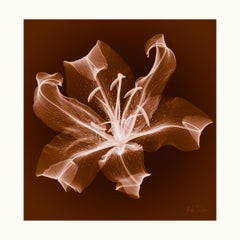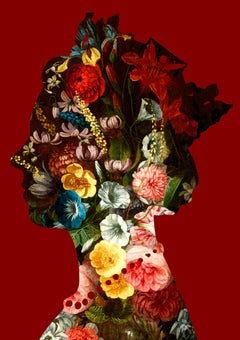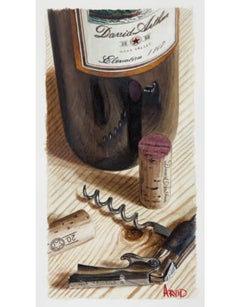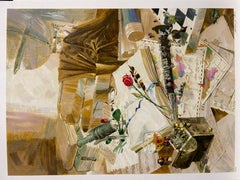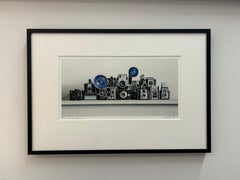Inkjet Still-life Prints
to
25
33
20
56
55
26
Overall Width
to
Overall Height
to
108
18
6
4
3
2
2
1
1
1
17
16
15
10
8
7
183
1
1
1
98
57
35
48
44
42
21
14
14
14
12
12
10
10
10
9
9
9
9
9
8
8
8
7,199
1,431
964
599
586
24
69
85
85
Medium: Inkjet
Laynes Lily - Classic Lily Flower X-Ray Print: Inkjet Print on Paper
By Hugh Turvey
Located in London, GB
In 2009, Hugh was appointed the first Artist in Residence for The British Institute of Radiology, since its inauguration in 1924 and Royal Charter granted by Her Majesty the Queen in...
Category
Early 2000s Contemporary Inkjet Still-life Prints
Materials
Paper, Inkjet
Agent X, One Queen (1) Red, Affordable Art, Floral Art, Art Online
By Agent X
Located in Deddington, GB
Agent X
One Queen (1) Red
Limited Edition of 50
Mixed Media on Paper
Sold Unframed
Paper Size: 72 cm x 50 cm x 1cm
Please note that in situ images are purely an indication of how a p...
Category
21st Century and Contemporary Contemporary Inkjet Still-life Prints
Materials
Giclée
Pearls, 2019, black and white hand-colored giclée by Shelter Serra
Located in Brooklyn, NY
Pearls, 2019, 15”x15” inches, unique hand-colored giclée on Somerset Velvet
This contemporary black and white hand colored giclée print depicts a string of pearls, symbols of luxury and exoticness.
The close perspective, and enlarged detail, brings the viewer deep into the picture frame, indicating potential intimacy and future wealth.
Shelter Serra’s paintings, sculptures, and drawings explore mass consumption and cultural identity. He juxtaposes subject matters that are both common and recognizable: a Campbell's Soup Can, a copper plated baseball hat, and a Hermes Birkin bag...
Category
21st Century and Contemporary Contemporary Inkjet Still-life Prints
Materials
Paper, Giclée
Higher Ground
Located in Toronto, ON
25" x 18.5" Framed
Limited Edition Giclée on Paper
Numbered of 295
Hand Signed by Thomas Arvid
Category
21st Century and Contemporary Inkjet Still-life Prints
Materials
Giclée
Memories
Located in Toronto, ON
24" x 30" Unframed
Limited Edition Print of 275
Hand Signed by Michael Gorban
Category
21st Century and Contemporary Inkjet Still-life Prints
Materials
Giclée
$1,400
Fourteen Cameras - unframed print
Located in Fairfield, CT
This print is sold UNFRAMED.
Stott’s work is almost object portraiture, applying traditional still life compositions and lighting but ventures beyond time honored subject matter. ...
Category
2010s Realist Inkjet Still-life Prints
Materials
Archival Paper, Giclée
Giclée Print: 'UTURN'
Located in New York, NY
GRAPHICTHERAPY is David Calderley:
an Englishman in New York, Creative/Art Director, Graphic Designer and Illustrator. After graduating from the esteemed St. Martin’s School of Art in Covent Garden, London and beginning a freelance career, he moved to New York City in 1990. Over the last 30+ years he has designed over 1200 albums and single covers, as well as promotional and full campaigns for a myriad of artists including, Interpol, Madonna, The White Stripes, RZA, Moby, The Black Crowes, Elvis Costello, to name a few.
After a 10 year spot as the Creative Director for Sir Richard Branson’s North American Record Label V2, he set up GRAPHICTHERAPY in 2007, a small boutique creative agency that offers a complete range of design services, both in print and media.
A unique mix of art direction, design and creative illustration can be seen across a wide variety of brands, products and publications in music, fashion, events and campaigns. His largest illustrated piece is a 90ftx50ft mural on 57th and Park Avenue for the British menswear company, Turnbull & Asser, as part of their rebrand. David’s work has been recognized by numerous global companies and publications, and has won several industry awards. He continues to work from his studio in Harlem.
This capsule of collage/mixed media prints:
‘Eating Vinegar with A Fork,’ reflecting a dry wit, as suggested in the title; juxtaposing formal Victorian etchings...
Category
2010s Contemporary Inkjet Still-life Prints
Materials
Giclée
"Leaves & Berries" giclée print after ca. 1950s original watercolor and collage
Located in Milwaukee, WI
14.75 x 17.75 inches, artwork
22.88 x 25.75 inches, frame
Born in 1908, Sylvia Spicuzza was the daughter of noted painter Francesco Spicuzza. Sylvia devoted herself to teaching art ...
Category
1950s Modern Inkjet Still-life Prints
Materials
Giclée, Watercolor
Collection on Table
Located in Toronto, ON
24" x 30" Unframed
Limited Edition Print of 275
Hand Signed by Michael Gorban
Category
21st Century and Contemporary Inkjet Still-life Prints
Materials
Giclée
Keys to the World
Located in Toronto, ON
24" x 40" Unframed
Limited Edition Giclee of 295
Hand Signed by Thomas Arvid
24" x 40" Unframed
Artist Proof of 185
Hand Signed by Thomas Arvid
24" x 40" Unframed
Limited Edition Giclee on Metal...
Category
2010s Inkjet Still-life Prints
Materials
Giclée
Inkjet still-life prints for sale on 1stDibs.
Find a wide variety of authentic Inkjet still-life prints available on 1stDibs. While artists have worked in this medium across a range of time periods, art made with this material during the 21st Century is especially popular. If you’re looking to add still-life prints created with this material to introduce a provocative pop of color and texture to an otherwise neutral space in your home, the works available on 1stDibs include elements of blue, orange, red, green and other colors. There are many well-known artists whose body of work includes ceramic sculptures. Popular artists on 1stDibs associated with pieces like this include Doug Bloodworth, Ryan Rivadeneyra, Shan Fannin, and Linda Rosewall. Frequently made by artists working in the Contemporary, Photorealist, all of these pieces for sale are unique and many will draw the attention of guests in your home. Not every interior allows for large Inkjet still-life prints, so small editions measuring 0.1 inches across are also available
Recently Viewed
View AllMore Ways To Browse
Christine Van Der Cingel
Christoffel Bisschop
Cinzano Vintage Prints
Claude Cambour
Claude Monet Spring In Giverny
Clayton Knight
Clifford Charman
Clifford Russell
Clive Madgwick
Clumber Spaniel Paintings
Clumber Spaniels
Colin Graeme Dog
Cowboy Tub
Cullen Yates
Dale Clark
Dali Hippocrates
Dan Brewer
Daniel Hernandez
